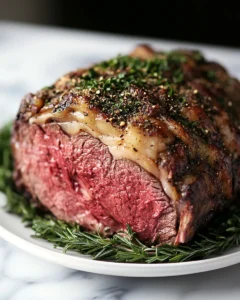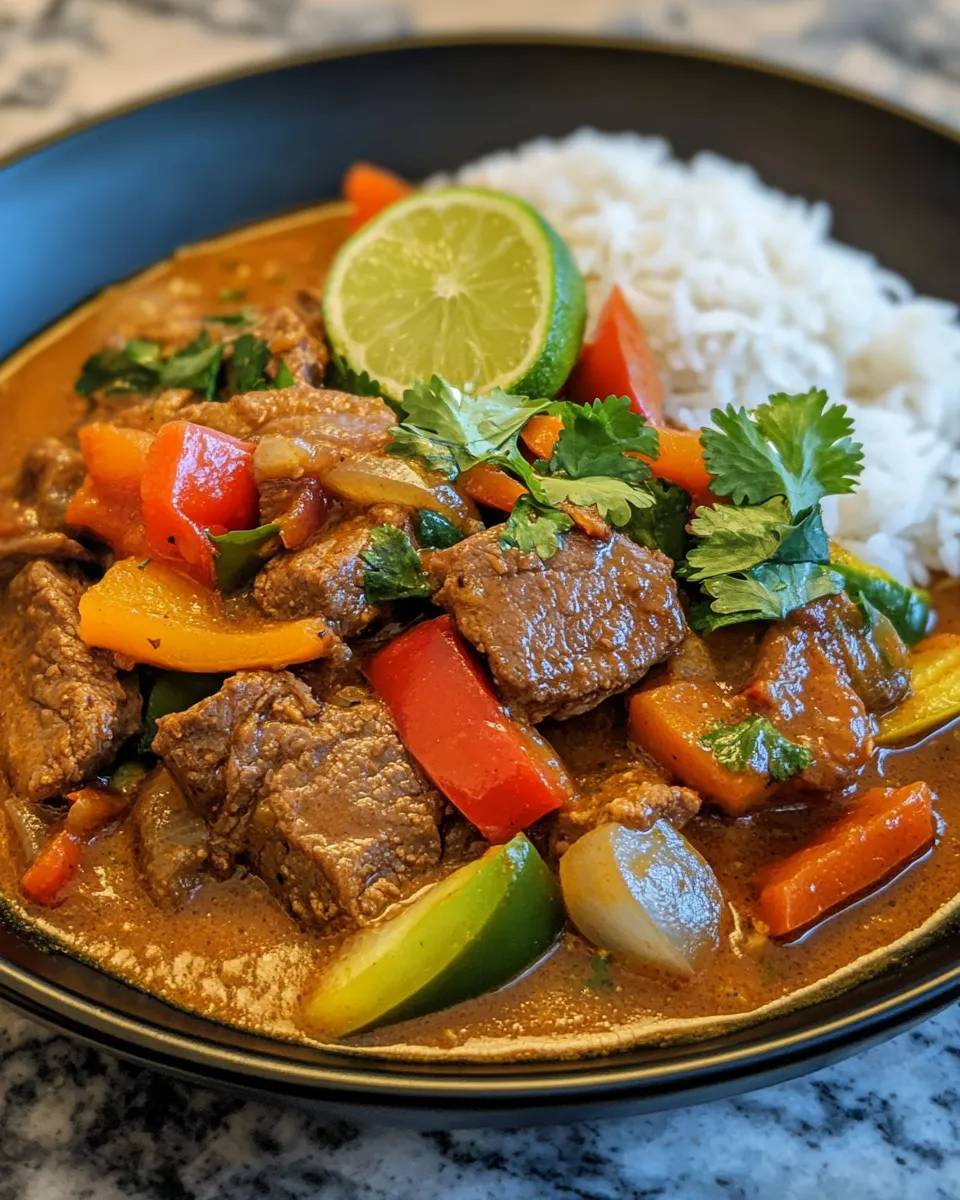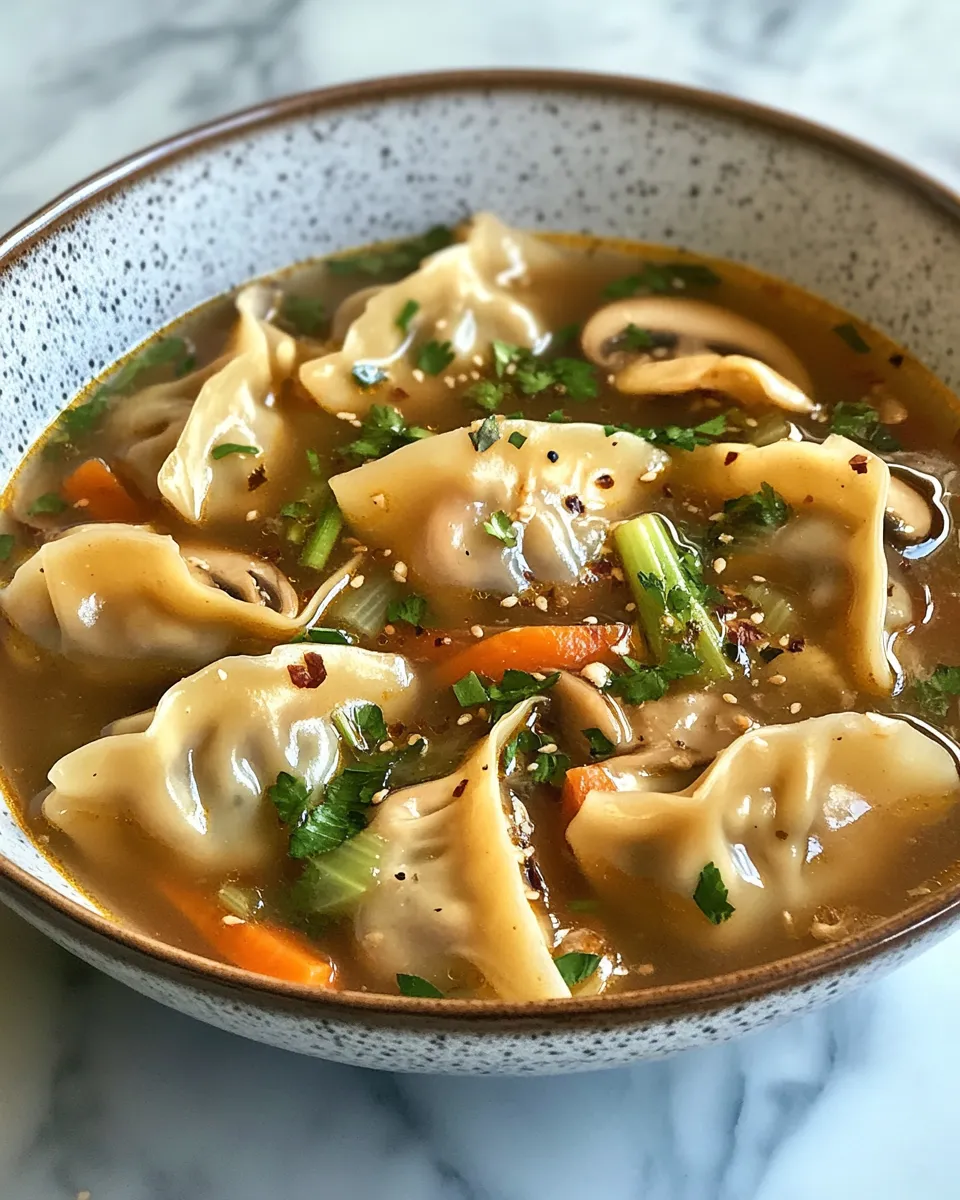There’s nothing quite like the aroma of a perfectly roasted prime rib filling your home during the holidays. Whether it’s a festive family gathering, a cozy winter evening, or a special occasion that calls for something extraordinary, this juicy, tender herb-rubbed prime rib roast is the ultimate centerpiece for your table. Inspired by generations of holiday feasts, this recipe celebrates the timeless tradition of slow-roasting a prime cut of beef to perfection. It’s the kind of dish that brings everyone together, inviting laughter, conversation, and that unmistakable feeling of warmth and comfort. With its golden, herb-crusted exterior and succulent, melt-in-your-mouth interior, this prime rib roast is sure to become a cherished holiday classic in your home.
Ingredients
-
1 (5-7 pound) prime rib roast, bone-in or boneless
-
4 tablespoons olive oil
-
4 cloves garlic, minced
-
2 tablespoons fresh rosemary, finely chopped
-
2 tablespoons fresh thyme, finely chopped
-
1 tablespoon fresh parsley, finely chopped
-
1 tablespoon coarse sea salt
-
2 teaspoons freshly ground black pepper
-
1 teaspoon onion powder
-
1 teaspoon paprika
-
1/2 teaspoon crushed red pepper flakes (optional for slight heat)
-
1 cup beef broth (for au jus)
-
2 tablespoons unsalted butter, softened
Directions
-
Prepare the Prime Rib
Begin by removing the prime rib from the refrigerator and allowing it to come to room temperature for about 2 hours. This ensures even cooking and enhances the tenderness of the meat. Pat the roast dry with paper towels to remove excess moisture, which helps achieve a beautifully browned crust. -
Make the Herb Rub
In a small bowl, combine olive oil, minced garlic, rosemary, thyme, parsley, sea salt, black pepper, onion powder, paprika, and red pepper flakes if using. Stir until a thick, fragrant paste forms. -
Apply the Herb Rub
Generously rub the herb mixture over the entire surface of the prime rib, pressing it gently to adhere. Make sure to coat all sides evenly, focusing on the top and the exposed ends of the roast. -
Prepare the Roasting Pan
Place a wire rack inside a large roasting pan. Set the prime rib on the rack, fat side up, to allow air circulation and even cooking. Insert a meat thermometer into the thickest part of the roast, avoiding bone if bone-in. -
Initial High-Temperature Roast
Preheat the oven to 475°F (245°C). Roast the prime rib at this high temperature for 20-30 minutes to create a flavorful crust. Keep a close eye to avoid burning, but don’t worry if the exterior is deeply golden—this is ideal. -
Lower the Temperature
Reduce the oven temperature to 325°F (165°C) and continue roasting. Cook until the internal temperature reaches your desired doneness: 120°F (49°C) for rare, 130°F (54°C) for medium-rare, or 140°F (60°C) for medium. For a 5-7 pound roast, this usually takes 1.5-2.5 hours depending on size and oven accuracy. -
Rest the Roast
Remove the prime rib from the oven and tent it loosely with aluminum foil. Let it rest for 20-30 minutes. Resting allows the juices to redistribute, ensuring every slice is moist and tender. -
Make the Au Jus
While the roast rests, place the roasting pan over medium heat on the stovetop. Add beef broth and stir, scraping up any browned bits from the bottom. Simmer for 5-10 minutes until slightly reduced. Finish with a touch of butter for richness. Strain if desired. -
Carve and Serve
Using a sharp carving knife, slice the prime rib against the grain into thick, juicy portions. Serve immediately with au jus on the side. Pair with roasted vegetables, creamy mashed potatoes, or a fresh salad for a complete holiday feast.
Tips for the Perfect Prime Rib
-
Choosing the Cut: Opt for a prime or choice-grade rib roast for optimal marbling, which ensures flavor and tenderness. Bone-in roasts tend to cook more evenly and retain moisture better than boneless cuts.
-
Seasoning in Advance: For maximum flavor, season the roast 24 hours in advance and refrigerate uncovered. This allows the seasoning to penetrate and the surface to dry slightly, creating a better crust.
-
Use a Meat Thermometer: Rely on a digital thermometer rather than guesswork. Internal temperature is the most accurate way to ensure your prime rib is cooked to perfection.
-
Resting is Crucial: Never skip the resting step. It’s the key to keeping every slice juicy rather than dry.
-
Customize Herbs: Feel free to experiment with additional herbs like sage or oregano to suit your taste.
Serving Suggestions
Pair your herb-rubbed prime rib with complementary sides to elevate the meal:
-
Classic Mashed Potatoes: Creamy, buttery mashed potatoes are a perfect canvas for the au jus.
-
Roasted Vegetables: Carrots, parsnips, and Brussels sprouts roasted with olive oil and garlic balance the richness of the meat.
-
Yorkshire Pudding: Traditional and fluffy, Yorkshire pudding soaks up the juices beautifully.
-
Fresh Salad: A crisp arugula or mixed green salad with a light vinaigrette adds a refreshing contrast.
-
Horseradish Sauce: A creamy horseradish sauce complements the savory flavor of the roast without overpowering it.
Why This Prime Rib Recipe Works
The beauty of this herb-rubbed prime rib lies in its simplicity. By combining fresh herbs, garlic, and a careful roasting technique, the natural flavor of the beef is enhanced without overpowering it. The initial high-temperature sear locks in juices and forms a delicious crust, while slow roasting ensures the interior remains tender and flavorful. Unlike recipes that rely on heavy sauces or complicated steps, this method emphasizes quality ingredients and proper technique, delivering a roast that looks stunning and tastes unforgettable.
Every holiday table deserves a centerpiece that impresses visually and delights the palate. This prime rib roast is not just a meal—it’s an experience. The golden herb crust, the tender pink interior, and the savory aroma that fills the kitchen create a sense of anticipation and celebration. It’s perfect for marking milestones, creating memories, and sharing the joy of a home-cooked feast with loved ones.
Storage and Leftovers
-
Refrigeration: Wrap leftover slices tightly in foil or an airtight container and refrigerate for up to 4 days.
-
Freezing: For longer storage, freeze slices in airtight containers or freezer bags for up to 3 months.
-
Reheating: Use a low oven (300°F / 150°C) or gently reheat in a skillet with a splash of broth to retain moisture.
Leftovers can also be transformed into sandwiches, tacos, or hearty beef salads, extending the joy of this holiday roast beyond a single meal.
Prep Time, Cook Time, Total Time, Yield
-
Prep Time: 30 minutes (+2 hours for bringing meat to room temperature)
-
Cook Time: 1.5–2.5 hours (depending on roast size and desired doneness)
-
Total Time: 2–3 hours
-
Yield: Serves 8–10
Notes
-
Adjust the herb combination to your taste; fresh herbs deliver the best flavor.
-
For added aroma, insert slivers of garlic into small incisions in the meat.
-
Use high-quality sea salt for better crust formation.
-
If you like a slightly spicier crust, add crushed red pepper or a pinch of cayenne.
-
Always let the meat rest; slicing too soon will release juices and result in a drier roast.
Frequently Asked Questions
Can I cook the prime rib without the bone?
Absolutely! While this recipe works beautifully with a boneless rib roast, using a bone-in prime rib often provides extra flavor and helps the meat retain moisture during cooking. The bone acts like a natural insulator, promoting even cooking and a juicier final product. If you choose a boneless roast, keep in mind that it may cook slightly faster, so start checking the internal temperature earlier to avoid overcooking. You can also tie the roast with kitchen twine to help maintain its shape and ensure even roasting. Both boneless and bone-in cuts can produce tender, succulent meat, so your choice depends on preference, availability, and presentation.
What is the best way to reheat leftovers?
Reheating prime rib properly is key to keeping it tender and flavorful. The gentlest method is to place the slices in a 300°F (150°C) oven, cover them with foil, and heat for 10–15 minutes. This allows the meat to warm evenly without drying out. Alternatively, you can gently reheat slices in a skillet over low heat with a splash of beef broth, which adds moisture and preserves the juices. For a convenient option, cold slices are excellent for sandwiches or salads—the flavor and tenderness remain surprisingly good. Avoid microwaving, as it can make the meat tough or rubbery.
How do I know when the prime rib is done?
A digital meat thermometer is your best tool for achieving perfect doneness. Insert it into the thickest part of the roast, avoiding the bone if it’s bone-in. For rare, aim for 120°F (49°C); medium-rare is ideal at 130°F (54°C); and medium reaches 140°F (60°C). Keep in mind that the roast will continue to cook slightly as it rests, so it’s best to remove it from the oven when it’s about 5–10 degrees below your target temperature. This ensures the slices are juicy and perfectly cooked throughout.
Can I prepare this recipe in advance?
Yes, prepping the roast ahead of time is a great way to simplify holiday cooking. Apply the herb rub and refrigerate the roast uncovered overnight. This not only enhances flavor but also helps the exterior dry slightly, which promotes a better crust during roasting. On the day of serving, simply bring the meat to room temperature before roasting for the best results. While the herb rub can be applied in advance, it’s recommended to cook and slice the roast fresh to fully enjoy its tender texture and juicy flavor.
Conclusion
There’s a reason prime rib has been a holiday favorite for generations. Its impressive presentation, mouthwatering flavor, and tender texture make it a dish worth mastering. This herb-rubbed prime rib roast recipe takes the guesswork out of holiday entertaining while ensuring every bite is a moment to savor. Whether it’s for a festive Christmas dinner, a special winter celebration, or simply an occasion that calls for something extraordinary, this roast promises to deliver flavor, warmth, and memories.
By following the simple steps in this guide, you’ll create a prime rib roast that not only tastes incredible but also inspires conversation and compliments around your table. From the fragrant herb crust to the perfectly cooked, juicy interior, every element of this dish is designed to impress.
Make this holiday season unforgettable—serve this juicy, tender, herb-rubbed prime rib roast, and enjoy the smiles, stories, and satisfaction that come from a meal prepared with care.
Print
Juicy Tender Herb-Rubbed Prime Rib Roast for the Holidays
- Total Time: 2–3 hours
- Yield: Serves 8–10 1x
Description
There’s nothing quite like the aroma of a perfectly roasted prime rib filling your home during the holidays. Whether it’s a festive family gathering, a cozy winter evening, or a special occasion, this juicy, tender herb-rubbed prime rib roast is the ultimate centerpiece for your table. Inspired by generations of holiday feasts, this recipe celebrates the timeless tradition of slow-roasting a prime cut of beef to perfection. With its golden, herb-crusted exterior and melt-in-your-mouth interior, this prime rib roast is sure to become a cherished holiday classic.
Ingredients
-
1 (5-7 pound) prime rib roast, bone-in or boneless
-
4 tablespoons olive oil
-
4 cloves garlic, minced
-
2 tablespoons fresh rosemary, finely chopped
-
2 tablespoons fresh thyme, finely chopped
-
1 tablespoon fresh parsley, finely chopped
-
1 tablespoon coarse sea salt
-
2 teaspoons freshly ground black pepper
-
1 teaspoon onion powder
-
1 teaspoon paprika
-
1/2 teaspoon crushed red pepper flakes (optional)
-
1 cup beef broth (for au jus)
-
2 tablespoons unsalted butter, softened
Instructions
-
Remove the prime rib from the refrigerator and let it come to room temperature for about 2 hours. Pat dry with paper towels.
-
In a small bowl, combine olive oil, garlic, rosemary, thyme, parsley, salt, black pepper, onion powder, paprika, and red pepper flakes. Mix into a thick paste.
-
Rub the herb mixture evenly over the entire roast, pressing gently to adhere.
-
Place a wire rack in a roasting pan and set the roast fat side up. Insert a meat thermometer into the thickest part, avoiding bone.
-
Preheat oven to 475°F (245°C) and roast for 20-30 minutes to form a crust.
-
Reduce oven temperature to 325°F (165°C) and continue roasting until internal temperature reaches 120°F (49°C) for rare, 130°F (54°C) for medium-rare, or 140°F (60°C) for medium.
-
Remove roast from oven, tent with foil, and rest 20-30 minutes.
-
For au jus, place roasting pan over medium heat, add beef broth, and stir, scraping browned bits. Simmer 5-10 minutes and finish with butter. Strain if desired.
-
Carve roast against the grain into thick slices and serve with au jus.
Notes
-
Seasoning in advance enhances flavor; refrigerate overnight if possible.
-
Use a digital thermometer for accurate doneness.
-
Resting the roast is essential for juicy slices.
-
Boneless roasts cook slightly faster than bone-in; adjust accordingly.
-
Customize herbs to your preference; fresh rosemary, thyme, and parsley work best.
- Prep Time: 30 minutes (+2 hours for bringing meat to room temperature)
- Cook Time: 1.5–2.5 hours








